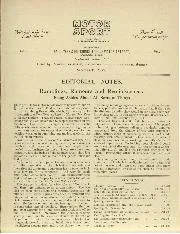
CONTENTS., January 1927
CONTENTS. Editorial Notes ... .•. ... ••• ••• ... 203-204 The " Napier-Campbell" Racing Car ••• 205-206, 210 Motor Racing Prospects for 1927 ... ... ... 207-210 How we went…
SLEEVE VALVES
Sir, I wish to thank 1Vr. R. P. G. Jones for another interesting (though sesquipedalian) letter. I have read and noted every word. I am however grieved to find that he has either missed or turned a blind eye to the salient points of mine. I set out to show that it was a waste of time to develop the Sleeve valve by automobile racing, (” Is this not one line in which motor-racing could prove its utility, i.e., by developing the sleeve ? ” he. asks), When existing types of rotary valve gear, notably the Cross, possess all its advantages and none of its disadvan
tages. I am not disputing the practicability of the sleeve valve, DaimlerKnight, Burt-McCullom, etc., have amply shown this, but I do maintain that the sleeve valve can never be developed to surpass the rotary valve in every respect. Mr. j ones puts forward no suggestions for overcoming the ” snags ” I enumerated, nor does he advance any destructive criticism of the rotary valve, so I take it my point is carried ? Since writing before I have had, the opportunity of examining at close quarters a Vincent-H.R.D. motor-cycle fitted with a 500 c.c. Cross engine and my respect and -affection for the marque has ripened thereby. This machine, which was not of the latest type, having had some fifteen months’ use as a ” hack bus ” with one overhaul during the period, was road tested recently by Motor Cycling” (28-5-37) and I make no apologies for quoting some of the performance figures obtained :—
Maximum Speeds : top 89 m.p.h.= 6,500 r.p.m. ; third 75 m.p.h.=6,800 r.p.m. ; second 01 m.p.h..7,400 r.p.m. ; first 40 m.p.h.=7,800 r.p.m.
Acceleration : to 40 M.p.h. in 5 sees.; to 60 m.p.h. in 9.8 Secs. ; to 80 m.p.h. in 181 secs.
Oil consumption (a weak point in a sleeve valve) 1,250 m.p.g. Fuel consumption (65 octane) 56 m.p.g.
A 350 c.c. engine of later design gave a maximum mean speed of 92 m.p.h. and was taken up to over 8,000 r.p.m. on the intermediates. I am sorry that the description of my pet was not clear to Mr. Jones. He is quite right in thinking that direct injection of the fuel (petrol) into the cylinders was intended. This method was used successfully in a two-cycle engine with electric ignition (the Violet, I believe) some ten years ago, when injection pumps were not SO good. It would appear to have advantages over injection into the manifold or blower in the matter Of stratification Of charge, of great importance in a two-cycle engine. However the engine is a hypothetical one and any arguments would inevitably be inconclusive. I duly note that ” is the keynote of success,” but the
exception often proves the rule, e.g., the Auto -Union, Napier ” Dagger,” Ariel ” Square Four,” or the 1 &litre Delage with its twelve wee cylinders, six dozen minute valve springs and twenty-seven horological timing wheels. Finally I must admit to having no
practical experience of the Frazer-Nash (not the F.N. please, lest we annoy Fabrique Nationale), but I admire it as one of the few British cars having a performance comparable with that of _a good solo motor-cycle. Incidentally at this point I would like to endorse: ” Spectators” letter, certainly a large percentage of drivers would have been the better for an apprenticeship on a motor-cycle. I am, Yours etc.,
IAN GORDON MACLEOD.
Birmingham.